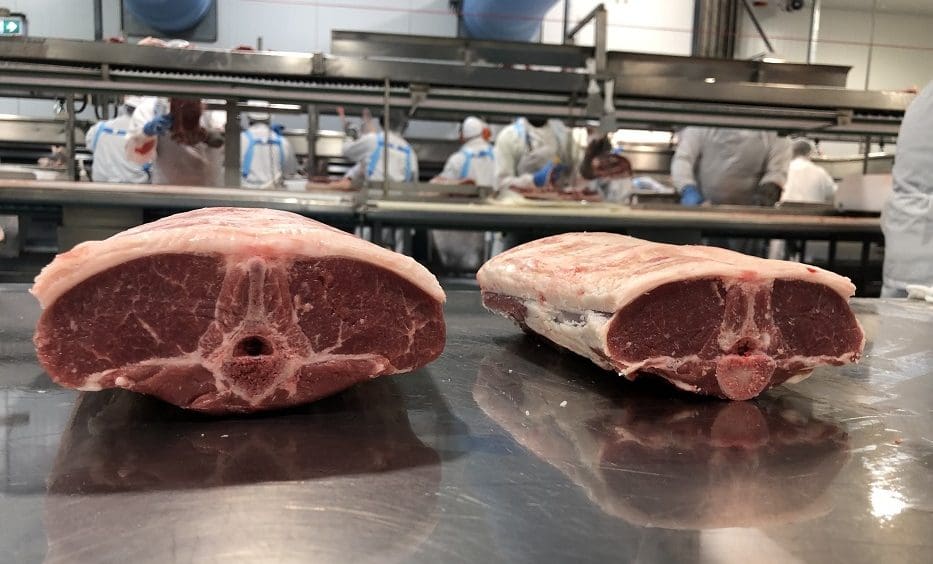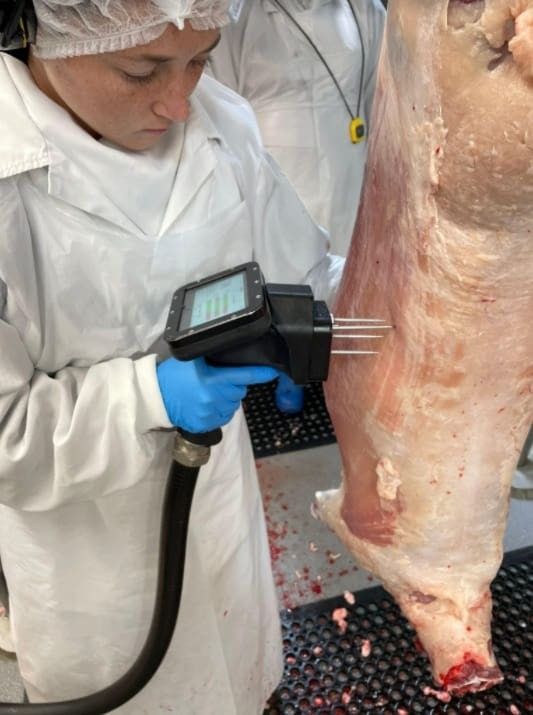
Loin cross sections show the difference between a high IMF lamb, left, compared to a lower IMF lamb, right, at the Gundagai Lamb plant.
NEW lamb eating quality technology is critical to maintaining the quality of the flock and of the lamb consumers’ eating experience, according to central west New South Wales seedstock producer Isabele Roberts.
And proper use of feedback from new lamb eating quality technologies and research can drive profitability, she said.
Since 2016, Meat Standards Australia’s research partner ALMTech has been working to develop advanced measurements of red meat quality and quantity to enhance the Australian beef, lamb and pork industries’ ability to respond to demands and capture value-chain price differentials.
By 2040, it is estimated that ALMTech will have generated as much as $510 million extra for the beef, lamb and pork industries in Australia.
For lamb, the ALMtech developments have included accredited measurement devices in plants – DEXA, fat and IMF measuring devices – with new language for whole carcase composition and IMF traits, critical to the rolling out the Meat Standards Australia model.
Ms Roberts’ family’s Ridgehaven Poll Dorset operation has used feedback from ALMtech developments to ‘ground truth’ her flock for eating quality and other carcase traits, mainly through Gundagai Lamb, the only processor currently paying producers on an intramuscular fat grid.
She would like to see more processors providing eating quality feedback, but recognised that commercial reality meant installing the new technology might be out of reach of some processors. There was also big variation among lamb producers and processors in the outcomes they are aiming for, she said.
She said Ridgehaven started looking at the relevance of eating quality traits in 2013 when very little data was going into Lambplan to create accurate eating quality Australian Sheep Breeding Values.
Rather than waiting for the nucleus flock to test enough genetics for the traits, Ridgehaven worked to ‘ground-truth’ the eating quality traits of the stud flock, while being cognisant of selection potentially compromising other traits.
“It was really easy to get an overfat slow-growing animal with intramuscular fat, but very difficult to get an optimised fat cover high growth animal with intramuscular fat.
“Our breeding program is much more about a balance of traits rather than looking for or driving towards one particular one,” she said.
“We didn’t want to be selecting for eating quality traits to the detriment of those performance traits that actually drive profitability.
“We want a moderate birth weight, good early growth, a high growth rate and good muscling, we want an optimum fat level for the muscle that you’ve got and those things equal a profitable lamb for commercial lamb producers.
“Those are critical things and if we can overlay an eating quality genetic profile to that then effectively we’ve got a balance of traits that provide people with the capacity to run a profitable lamb operation.
“Yes, I think we can, but have we got our flock to where we need to be, absolutely not.”

A MEQ probe being used on the GMP lamb chain to assess intramuscular fat level.
She said her end goal is to produce sheep that enable clients to produce high performance lamb with good eating quality balanced with lean meat yield “if that’s what they are looking for.”
Ms Roberts said Ridgehaven has been watching this MSA research develop over the years with great interest as she believed it has immense value for ram breeders.
“While some people may think of MSA as being about only about consumers, and so quite removed from those of us working at the very beginning of the supply chain, that’s not right because it all begins with us – it all begins with good genetics.
“If we are able to target eating quality more precisely through ASBVs, we are laying the foundations for the best eating experience for consumers and improved returns for everyone in the supply chain,” she said.
“The MSA program, together with Sheep Genetics and a number of MLA-funded genetics R&D programs, we have been given some really clear goalposts to aim for in data backed, accurate ASBV’s and so that’s what we are focussing on.”
ALMtech advancements are feeding into the supply chain
Researcher Dr Daniel Brown from the Animal Genetics and Breeding Unit at the University of New England said the ALMtech advancements are also feeding back down the supply chain to producers who are using ASBVs with greater focus on eating quality traits.
“We’ve been collecting data since 2007 through a range of industry and government-funded genetics R&D programs, and from that we developed breeding values in 2013 for eating quality and yield related traits,” he said.
This work has also contributed to the development of a cuts-based grading model for the lamb industry to create value through segregation of cuts based on quality, as well as helping breeders make better genetic selection decisions.
“MSA has always been thought about as a metric to describe eating quality to improve consumer experience, and therefore draw out more value for processors and producers, but we are seeing that it has also put value around desirable genetic traits allowing breeders to balance their selection appropriately across traits.
“I know that there are already several breeders that are developing lines of seedstock animals that are targeted towards particular eating quality attributes and their progeny are being slaughtered and marketed as having those attributes. So, the rewards are already being felt by some.
“It’s exciting to see this research go both up and down the supply chain to make a real difference.”
Dr Brown said the readiness of producers to apply this research was a credit to them.
“Producers have jumped in and set about understanding the impacts of MSA measurements for lamb meat yield and eating quality and, particularly ram breeders, have turned it around and used it to create value – it’s very impressive.”
For more information on ALMtech click here.



HAVE YOUR SAY